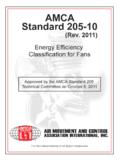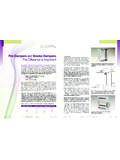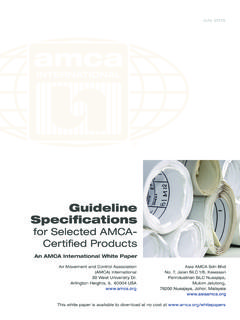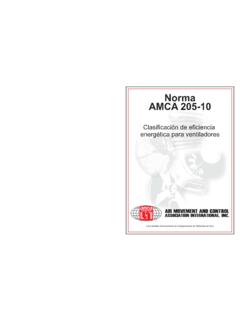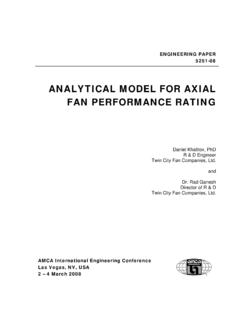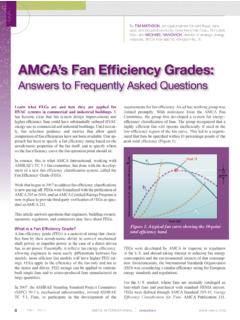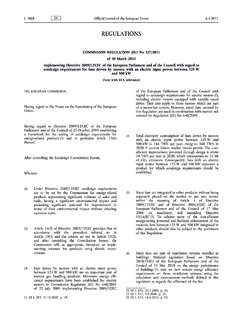Transcription of Understanding the ANSI/AMCA Standard 500-L Tests
1 Understanding the ANSI/AMCA Standard 500-L TestsAn AMCA International White PaperMarch 2017 This white paper is available to download at no cost at Movement and Control Association (AMCA) International 30 West University Heights, IL 60004 L. BLAHA, RUSKIN &THE AMCA LOUVER MARKETING TASK FORCESEND COMMENTS AND SUGGESTIONS TO MICHAEL IVANOVICH, SENIOR DIRECTOR, INDUSTRY RELATIONS, AMCA INTERNATIONAL, white paper describes the Tests outlined in ANSI/AMCA Standard 500-L , helping specifiers understand what testing in accordance with this AMCA stan-dard proves and does not prove about the louver they are considering for a you review a louver s submittal sheet, you will often see technical information that describes the louver s per-formance. These submittal sheets help engineers assess if the louver has the right performance attributes for their project s requirements. Louvers are designed to protect air intake and exhaust openings from the infiltration of unwanted water or particles while allowing airflow into the space, and different louver models offer varying levels of performance.
2 Many times, certain louvers are selected because the building needs a specific kind of performance. For instance, the performance of a louver can be especially critical when there is machinery or equipment behind it that must stay dry and free of a louver s performance is so critical, the obvious question is this: when reviewing a louver s submittal sheet, how can we be sure that the performance stated on the sheet is accurate?The Air Movement and Control Association (AMCA) International acts as the means of providing this assurance. It publishes test standards that are universally accepted in the industry, and it provides third-party testing to confirm the accuracy of manufacturer data. AMCA s members companies that manufacture air movement and control products must agree to accurately represent the performance of their products and abide by a stringent code of publishes a Standard , ANSI/AMCA Standard 500-L1, that outlines the testing protocols of louvers.
3 Its goal is not to establish minimum/maximum performance ratings but rather to outline a standardized method for testing louvers for different parameters. Its origins can be traced back to a historical Standard , AMCA Standard 500, called Interim Test Methods for Louvers, Dampers and Shutters. The creation of this Standard coincided with AMCA welcoming a number of new member companies that designed and built louvers, dampers and shutters, leading to the adoption of control in AMCA s air movement and control name in 1971. AMCA Standard 500 went through five revisions before being split off into 500-D for damper testing in 1998 and 500-L for louver testing in the ANSI/AMCA Standard 500-L the original publishing of ANSI/AMCA Standard 500-L , there have been many updates, and the most recent version was published in 2015. It is the Standard to which all louvers are tested, and its test protocols are what the AMCA Certified Ratings Program (CRP)2 uses to certify that a louver s reported data is accurate.
4 AMCA then allows the company to place a CRP seal on the certified product (Figure 1). TAKING A CLOSER LOOK AT THE ANSI/AMCA Standard 500-L TESTST here are currently five testing protocols covered in ANSI/AMCA Standard 500-L . These are Pressure drop Airflow leakage Water penetration Wind-driven rain Wind-driven sandThese testing protocols are all conducted by AMCA at one of their accredited laboratories. Once a CRP participant has its louvers tested at one of AMCA s facilities and has proven the accuracy of its ratings, that manufacturer can display the test results on its louver submittal page, along with an image of the AMCA CRP seal that corresponds to the testing that was done. In some cases, louvers can be certified for multiple performance factors and gain the right to display more than one DROP TESTThe AMCA Standard 500-L test for pressure drop determines a louver s resistance to air some equipment needs air to operate effectively, airflow is an important factor.
5 If you are considering a louver for a space containing this type of equipment, its pressure drop test results should be one of the first things you look reviewing a louver s submittal sheet, how can we be sure that the performance stated on the sheet is accurate? Figure 1. CRP seals for air performance (pressure drop), water penetration/air performance, air leakage. test protocol is to take five or more determinations in a desired range of airflow rates, using equal increments. One reading per determination is taken for each of the following: Outlet duct static pressure Inlet duct static pressure Discharge chamber static pressure Inlet chamber static pressure At the AMCA laboratory, ambient temperatures during the test are between 10 degrees Celsius and 40 degrees Celsius (50 degrees Fahrenheit and 104 degrees Fahrenheit). The test requires a complete set of air measure-ments for one setting of airflow and pressure drop.
6 Most often, the louver is tested with the air flowing in both directions. However, testers make exceptions for louvers that are specified for airflow in one direction only. The test for operable louvers begins with the lowest airflow value. It is left to find its own equilibrium position in the pressure Standard 500-L specifies that, for pressure drop, a 1219 mm 1219 mm (48 in. 48 in.) louver sample must be tested. The information on the louver s submittal page reflects the results of the 1219 mm 1219 mm (48 in. 48 in.) sample. This is important to understand because, with a larger section size, a pressure drop test would have reflected a lessened resistance to airflow. Conversely, a smaller section size than the one tested would show an increased 2 shows an example of a pressure drop chart that would appear on a manufacturer s submittal TEST SETUPSAIR PERFORMANCE PRESSURE DROP MEASUREMENTS SETUPSTEST FIGURECONNECTION PLANETEST FIGURECONNECTION PLANE5.
7 1Z6 .. 2. Example pressure drop the final report is presented, it will include the test data along with the following criteria called out on the report: Blade orientation Blade action Blade position (open or closed) Airflow direction Personnel Date that the test was conducted Model Louver type Size Free area Te st fi g u reAIR LEAKAGE TEST FOR ADJUSTABLE AND COMBINATION LOUVERSThe ANSI/AMCA Standard 500-L test for air leakage determines the relationship between the airflow leakage rate and the static pressure for a louver mounted in a test chamber. This test can aid you in properly selecting a louver for a building s needs after considering airflow, the need for energy savings and the importance of having a sealed building with the Standard s pressure drop test, there are five or more determinations that are taken at equal increments of pressure differential that cover a desired range during equilibrium conditions.
8 Testers use precisely measured weights, and they measure distance with devices having divisions of millimeters ( inches). For this test, multiple samples of the louver are required. Testers use the following criteria for samples: Minimum width maximum height Maximum width minimum height Maximum width maximum heightWhen completed, the finished report and conclusions of the test will include the following: Method of closure Blade orientation Blade action Airflow direction Personnel Date Test ID# Lab name Lab location Reference to ANSI/AMCA Standard 500-L Te st fi g u reEngineers concerned with the building s envelope should look for louvers that bear the AMCA CRP seal for leak-age. In these cases, a damper may not provide adequate leakage ( m) Mass (%)>699 0 2 0 . 0152-210 -10 3 <76 PENETRATION TESTThe water penetration test in ANSI/AMCA Standard 500-L is designed to determine the intake air velocity at which water begins to penetrate the louver.
9 A common misconception is that the test reports how much water penetrates the louver during service conditions ( , wind-driven rain). This is not the case. There are conditions in which wind-driven rain will not be a factor during service conditions of the louver, and this test is meant to show how the louver will perform under what are considered typical conditions rather than heavy rains or windy this testing protocol, water droplets are released in front of the louver to mimic a light, vertical rainfall. The simulated rainfall is dropped in front of the louver at a rate of 100 mm (4 in.) per hour, minimum L/m per linear meter ( gpm per linear foot) , which simulates water coming down an exterior wallThe testing sample size for the louver is 1219 mm 1219 mm (48 in. 48 in.). At the back of the testing chamber behind the louver, an intake fan is positioned. The intake fan attempts to draw water through the louver during the test.
10 This is known as a still air testing, the beginning point of water penetration is determined at the free area intake velocity. For the minimum test point, the test is run at conditions in which the water collected on the floor of the testing chamber does not exceed 3 g/m2 ( oz/ft2) of free area. The finished results are cataloged on the louver submittal sheet and are represented with a graph similar to the one pictured 0110 ..100 . :m/s:Free Area VelocityWater Penetration Per Unit Free AreaTest Size: 1219 mm 1219 mm (48 in. x 48 in.)Test Period: 15 minutesStandard Air: kg/m3 ( lb/ft3)Figure 3. Example water penetration the example above, the beginning point of water penetration is m/s (1002 fpm) free area maximum intake velocity, m/s (1250 fpm) for the louver test and on most submittal sheets, is represented as a single point without the test report and results for the ANSI/AMCA Standard 500-L water penetration test includes the following information: Personnel Date Test ID# Lab name Lab location Reference to ANSI/AMCA Standard 500-L Te st fi g u re Model Louver type size Free area Any appurtenances, such as drain pansThe test is important for specifiers because, in many cases, the space behind the louver needs to be kept dry, particularly when adequate drainage does not RAIN TESTIt is not uncommon to see a louver submittal sheet display the CRP seal for both water penetration and wind-driven rain.
